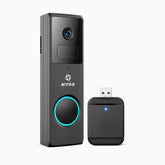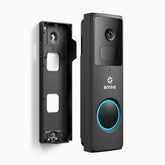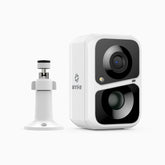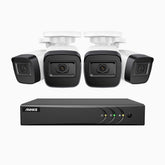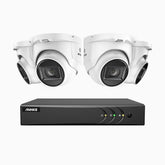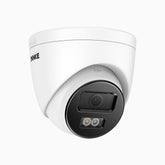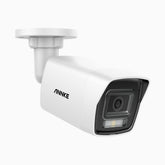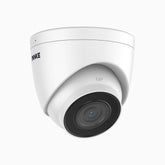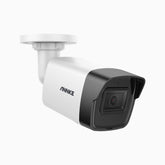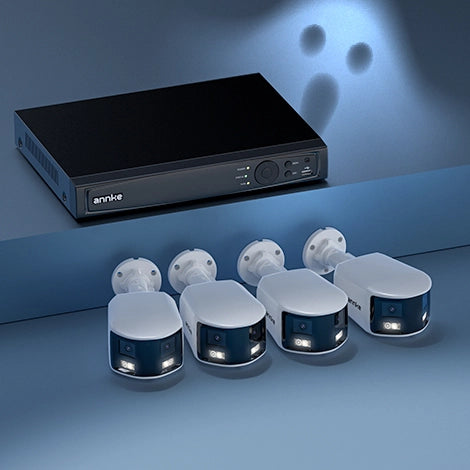Understanding Security Camera Night Vision: IR, Color, Dual-Light, and Beyond
When the sun sets, your surroundings change, and so does the way your camera sees them. Have you ever checked your footage at night and noticed how faces blur, license plates vanish, or everything turns into shades of gray?

That’s exactly why night vision exists, to help your camera keep watching when you can’t. From invisible infrared beams to full-color low-light imaging, night vision technology has evolved far beyond the grainy black-and-white footage you might remember. Today’s systems can reveal the details that matter most, even when the world around you is pitch dark.
But with so many types — IR, color, dual-light, and even hybrid fusion — how do you know which one actually fits your home, your shop, or your project? In this guide, we’ll break it all down in plain language, explore how each technology works, so you can pick the technology that truly fits your world after dark.
1. Infrared Night Vision (IR): The Classic Approach
Infrared night vision is the foundation of most security cameras today. These cameras use small infrared LEDs that emit light invisible to the human eye. When light levels drop, the camera’s IR-cut filter automatically switches to night mode, using this invisible light to create a black-and-white image.
IR night vision is ideal for total darkness because it doesn’t rely on visible light. It’s discreet — intruders often won’t realize they’re being recorded. However, it can’t display true color, and its range depends heavily on the strength and number of IR LEDs.
It’s simple, reliable, and cost-effective. The tradeoff? No color information. That means while you can see shapes clearly, you won’t know the color of a vehicle or the clothes someone is wearing.
IR cameras are great for areas where stealth matters more than color — for example, entrances, corridors, or dark alleys. If you’re looking for a reliable option, ANNKE’s IR-powered models such as the C500 and C800 deliver strong low-light performance with extended range and crisp black-and-white detail — perfect for quiet night monitoring. (Explore more: ANNKE C300/C500)
2. Color Night Vision: Seeing in Color After Dark
Color night vision takes things a step further. Instead of switching to black and white in low light, these cameras continue delivering full-color images, giving you a realistic view even after sunset.
It works by gathering and maximizing every bit of available light. A larger aperture (a smaller f-number like f/1.0–f/1.6) allows more light to enter the lens — just like how your pupils widen in the dark. Combined with a high-sensitivity sensor, the camera can capture and amplify even the faintest ambient light from street lamps or the moon, turning near-darkness into a colorful, detailed image.
Some color night vision models also include built-in soft warm LEDs, which gently illuminate the scene without overwhelming it. This small touch helps the sensor read colors accurately while keeping the image natural.
Advantages:
Delivers realistic color footage, helping you identify cars, clothing, and surroundings more easily.
Works great in dim environments like driveways, porches, or shopfronts with mild lighting.
Limitations:
In total darkness, color night vision requires some ambient light or built-in LEDs to produce color. When it activates its soft light, intruders may notice the glow — which means it’s not the best fit for situations that demand complete discretion, such as covert monitoring or sensitive facilities.
That’s exactly what ANNKE’s NightChroma™ 3.0 technology was designed to overcome — bringing vivid, true-to-life color to nighttime footage while maintaining low-light sensitivity and subtle illumination.
Whether you prefer a PoE setup for stable wired power or a CCTV model for existing systems, NightChroma 3.0 PoE Cameras and NightChroma 3.0 CCTV Cameras deliver stunning color clarity even when other cameras fade to black.
Curious about how this technology works behind the scenes? Dive deeper in our detailed post: Inside NightChroma 3.0 — The Science of True Color at Night
3. Dual-Light Technology: Smarter Illumination
Dual-light cameras automatically switch between infrared and color night vision depending on conditions. Under normal conditions, they stay in discreet IR mode to save energy and reduce light pollution. But when motion is detected, the camera automatically switches on white light, instantly capturing color footage of the event.
This “smart switch” balances stealth and visibility, saves power, reduces glare, making it ideal for driveways, parking lots, or business entrances. You get detailed, colorful evidence only when you actually need it - just like in ANNKE’s FCD800, which smartly combines infrared and white light to deliver clarity only when motion occurs.
4. Starlight & Low-Light Sensors: Seeing in Color, Even in the Dark
Earlier, we mentioned high-sensitivity “starlight” or low-light sensors — technologies designed to see more when light is scarce. Some of the most advanced cameras today use true starlight-grade sensors, engineered to capture color detail even under extremely dim conditions.
So, how does a more sensitive sensor create color images in the dark?
It all comes down to light absorption efficiency. Starlight sensors feature larger pixels and back-illuminated designs that gather more photons — the basic units of light — and convert them into image signals more effectively. This heightened sensitivity allows them to reproduce colors even when illumination levels drop below 0.001 lux, roughly equivalent to a clear, moonlit night.
In practical terms, that means you get smooth, low-noise color footage without switching on visible lighting or additional LEDs. If you’d like to quickly explore examples of cameras using this technology, check out ANNKE CZ504P 3K PTZ Camera and NCBR800 4K Ultra HD PoE Camera — both deliver vivid, realistic color even in near darkness.
These sensors are commonly found in high-end home and commercial cameras, where customers expect clear, true-to-life images at all hours — without sacrificing discretion or reliability.
5. Thermal Imaging: Seeing Heat, Not Light
Thermal cameras detect heat signatures instead of visible light. Every object emits infrared radiation, and the camera translates these variations into a thermal image.
That means thermal vision works in complete darkness, fog, or smoke — conditions where other night vision fails. The result isn’t a traditional photo but a heat-based image.
However, thermal images don’t show fine details like faces; they highlight presence and movement. These are best for industrial sites, warehouses, and perimeter defense where early detection is key.
6. Hybrid / Fusion Night Vision: The Future of Low-Light Imaging
Hybrid or Fusion Night Vision systems combines two or more imaging technologies — for instance, infrared + visible light, or low-light + thermal imaging, to ensure visibility in nearly any environment.
For example, in total darkness or heavy fog, thermal imaging detects heat signatures instead of visible light, allowing the camera to “see” people, vehicles, or animals even when there’s no light at all. Meanwhile, infrared and low-light fusion systems merge details from both image types — the clarity of optical imaging with the consistency of infrared — producing balanced, usable footage across all conditions.
If you’re curious about how this technology works in real life, take a look at ANNKE I81HZ - Thermal & Optical Bi-spectrum Cam and I81DY — both integrate dual-spectrum imaging for round-the-clock precision in the most demanding environments.
In simpler terms, these systems adapt intelligently: when the scene is dim but not pitch-black, the camera relies on low-light or starlight imaging to capture color detail; when illumination drops to zero, it automatically switches to infrared or thermal detection for continued visibility.
This hybrid approach dramatically enhances reliability in extreme environments — from outdoor security during harsh weather to industrial sites with mixed lighting. Best for: advanced security applications or users who want all-in-one adaptability.
How to Choose the Right Night Vision for Your Needs
The best night vision system depends on where you’re installing the camera, what kind of detail you need, and how visible you want the system to be.
For home security, your priorities are usually coverage and safety. If you’re monitoring driveways, gardens, or entryways, color night vision offers a more natural, lifelike image — helpful for identifying faces, vehicles, and even clothing colors. However, if you prefer something discreet that doesn’t draw attention, infrared black-and-white night vision remains a solid and reliable option. It keeps your camera invisible at night while delivering clear motion detection.
For small businesses or shops, lighting conditions often change — some areas may stay lit while others go dark after hours. In these cases, starlight or low-light sensors are a strong middle ground. They capture detail and color in dim conditions without the need for bright illumination, reducing glare and power consumption.
For industrial or engineering projects, durability and adaptability matter most. Warehouses, construction zones, and outdoor facilities face varying temperatures, dust, and humidity. This is where hybrid or fusion night vision systems excel. By combining infrared, low-light, and sometimes thermal imaging, they ensure consistent performance even in rain, fog, or total darkness.
When comparing models, think about three main factors:
Budget: Standard IR cameras are the most affordable; starlight and hybrid systems sit at the higher end but deliver far greater clarity and flexibility.
Image clarity: Higher resolution helps, but only if the lens and lighting conditions match your needs.
Stealth vs. visibility: Color night vision looks beautiful, but infrared is less noticeable and better for hidden monitoring.
Final Thoughts
Night vision is no longer just about seeing in the dark, it’s about understanding what you see. From simple black-and-white IR footage to smart fusion systems that adapt to every level of darkness, each type of night vision offers something unique:
Infrared (IR): Reliable and discreet.
Color night vision: True-to-life detail under low light.
Starlight / low-light sensors: Excellent balance of color and clarity.
Hybrid / fusion: The next generation for complex environments.
The key is to match the technology to your specific scenario. Think about your surroundings, lighting conditions, and what kind of detail you want to see after dark. At the end of the day, the best camera isn’t just the one with the most features — it’s the one that helps you feel secure and confident.
